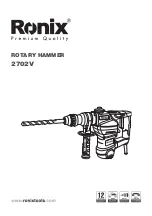
6
and pull the bit out.
Fig.8
Depth gauge
Fig.9
The depth gauge is convenient for drilling holes of
uniform depth. Loosen the side grip and insert the depth
gauge into the hole in the side grip. Adjust the depth
gauge to the desired depth and tighten the side grip.
NOTE:
•
The depth gauge cannot be used at the position
where the depth gauge strikes against the gear
housing.
Dust cup
Fig.10
Use the dust cup to prevent dust from falling over the
tool and on yourself when performing overhead drilling
operations. Attach the dust cup to the bit as shown in the
figure. The size of bits which the dust cup can be
attached to is as follows.
Bit diameter
Dust cup 5
6 mm - 14.5 mm
Dust cup 9
12 mm - 16 mm
006406
OPERATION
Hammer drilling operation
Position the bit at the desired location for the hole, then
pull the switch trigger. Do not force the tool. Light
pressure gives best results. Keep the tool in position and
prevent it from slipping away from the hole.
Do not apply more pressure when the hole becomes
clogged with chips or particles. Instead, run the tool at
an idle, then remove the bit partially from the hole. By
repeating this several times, the hole will be cleaned out
and normal drilling may be resumed.
CAUTION:
•
There is a tremendous and sudden twisting force
exerted on the tool/bit at the time of hole
break-through, when the hole becomes clogged
with chips and particles, or when striking
reinforcing rods embedded in the concrete. Always
use the side grip (auxiliary handle) and firmly hold
the tool by both side grip and switch handle during
operations. Failure to do so may result in the loss
of control of the tool and potentially severe injury.
NOTE:
Eccentricity in the bit rotation may occur while operating
the tool with no load. The tool automatically centers itself
during operation. This does not affect the drilling
precision.
Blow-out bulb (optional accessory)
Fig.11
After drilling the hole, use the blow-out bulb to clean the
dust out of the hole.
Drilling in wood or metal
Fig.12
Fig.13
Use the optional drill chuck assembly . When installing it,
refer to "Installing or removing drill bit" described on the
previous page.
Hold the ring and turn the sleeve counterclockwise to
open the chuck jaws. Place the bit in the chuck as far as
it will go. Hold the ring firmly and turn the sleeve
clockwise to tighten the chuck.
To remove the bit, hold the ring and turn the sleeve
counterclockwise. Set the action mode changing knob to
"rotation only".
You can drill up to 13 mm diameter in metal and up to 32
mm diameter in wood.
CAUTION:
•
Never use "rotation with hammering" when the drill
chuck assembly is installed on the tool. The drill
chuck assembly may be damaged.
Also, the drill chuck will come off when reversing
the tool.
•
Pressing excessively on the tool will not speed up
the drilling. In fact, this excessive pressure will only
serve to damage the tip of your bit, decrease the
tool performance and shorten the service life of the
tool.
•
There is a tremendous twisting force exerted on
the tool/bit at the time of hole breakthrough. Hold
the tool firmly and exert care when the bit begins to
break through the workpiece.
•
A stuck bit can be removed simply by setting the
reversing switch to reverse rotation in order to back
out. However, the tool may back out abruptly if you
do not hold it firmly.
•
Always secure small workpieces in a vise or similar
hold-down device.
•
When performing diamond core drilling operations,
always set the change lever to the
position to
use "rotation only" action. If performing diamond
core drilling operations using "rotation with
hammering" action, the diamond core bit may be
damaged.
MAINTENANCE
CAUTION:
•
Always be sure that the tool is switched off and
unplugged before attempting to perform inspection
or maintenance.
To maintain product SAFETY and RELIABILITY, repairs,
carbon brush inspection and replacement, any other
maintenance or adjustment should be performed by
Содержание HR2460
Страница 43: ...43 ...
Страница 44: ...44 Makita Corporation Anjo Aichi Japan 884705B971 ...







































